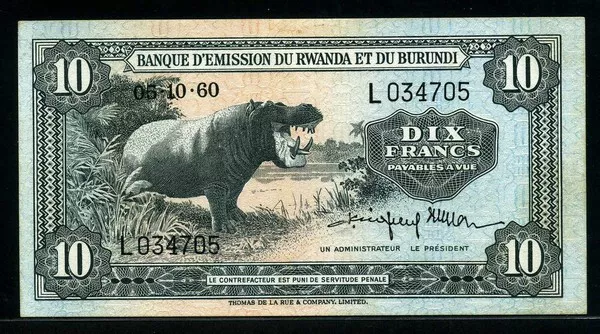In the realm of global currencies, the Burundi Franc (BIF) stands as a testament to Burundi’s economic history and resilience. This article embarks on a comprehensive journey through the intriguing evolution of the Burundi Franc, exploring its historical roots, symbolic representation, currency codes, and the diverse denominations that make it a vital component of Burundi’s economic landscape.
Burundi Franc Currency History
The history of the Burundi Franc is a narrative woven with the threads of Burundi’s economic development. The currency traces its origins back to the early 20th century when the region was under Belgian colonial rule. The Belgian Congo Franc initially served as the currency for both Rwanda and Burundi until the countries gained independence in 1962.
Post-independence, Burundi introduced its own currency, the Burundi Franc, which replaced the Belgian Congo Franc. This move was a crucial step in asserting Burundi’s economic sovereignty and establishing a distinct financial identity. Over the years, the Burundi Franc has witnessed various economic shifts, and its history reflects the nation’s journey through periods of stability, challenges, and growth.
Burundi Franc Currency Symbol
Symbols transcend mere representation; they encapsulate the spirit and identity of a currency. The symbol associated with the Burundi Franc is “FBu,” an abbreviation derived from the French “Franc du Burundi.” This symbol is not just a typographical element; it is a visual marker that signifies Burundi’s economic autonomy and the strength of its financial system.
The “FBu” symbol is a fusion of letters that transcends linguistic boundaries, providing a universal identifier for the Burundi Franc in the global financial arena. It is a visual manifestation of Burundi’s economic narrative, representing the nation’s journey from colonial financial systems to an independent, sovereign currency.
Burundi Franc Currency Codes
In the intricate web of international finance, currency codes play a pivotal role in facilitating seamless transactions and communication. The Burundi Franc is associated with two primary currency codes:
ISO Code: BIF
Numeric Code: 108
The ISO code (BIF) serves as a standardized shorthand for the Burundi Franc in international financial transactions. The numeric code (108) further enhances precision, ensuring that there is no room for ambiguity in the vast landscape of global trade and finance.
These codes are not mere technicalities; they are the linguistic backbone of Burundi’s financial interactions with the world. They contribute to the accuracy and efficiency of cross-border transactions, reinforcing Burundi’s position in the international economic arena.
Burundi Franc Denominations
The Burundi Franc exists in various denominations, each meticulously designed and strategically assigned to cater to the diverse needs of its users. The common denominations of the Burundi Franc include:
Burundi Franc Coins:
1 franc
5 francs
10 francs
50 francs
100 francs
500 francs
These coins, with their varying sizes and distinct features, form an integral part of everyday transactions, contributing to the liquidity and efficiency of the Burundi Franc.
Burundi Franc Banknotes:
500 francs
1,000 francs
2,000 francs
5,000 francs
10,000 francs
20,000 francs
50,000 francs
The banknotes, adorned with images reflecting Burundi’s cultural heritage and historical significance, serve as tangible representations of the nation’s economic strength. Each denomination tells a story, from the intricate artwork to the security features embedded to prevent counterfeiting.
Security Features of Burundi Franc
Maintaining the integrity of its currency is paramount for any nation, and Burundi is no exception. The Burundi Franc incorporates advanced security features in its banknotes to safeguard against counterfeit activities. These features not only ensure the authenticity of the currency but also reflect Burundi’s commitment to maintaining the highest standards in its financial instruments. Some of the security features include:
Watermark: An embedded watermark featuring a prominent figure or symbol adds complexity to the banknote, deterring counterfeiters.
Security Thread: A metallic thread woven into the banknote with intricate patterns and holographic effects enhances its visual appeal and serves as a security measure.
Microprinting: Tiny, finely printed text that is challenging to replicate using standard printing methods.
These security measures collectively contribute to the resilience of the Burundi Franc, assuring both local and international users of its authenticity and reliability.
Burundi Franc in the Global Economy
While Burundi may be a small landlocked country in East Africa, the Burundi Franc plays a significant role in the nation’s economic landscape. Burundi’s economy is predominantly agrarian, and the Burundi Franc facilitates domestic transactions, contributing to the stability of the country’s financial system.
In the context of international trade, the Burundi Franc serves as a conduit for economic cooperation. Its stability and consistent exchange rate contribute to the trustworthiness of Burundi as a trade partner. However, like any currency, the Burundi Franc is not immune to the challenges posed by the global economic landscape.
Conclusion
The Burundi Franc, with its historical roots, symbolic representation, precise codes, and diverse denominations, is a cornerstone of Burundi’s economic identity. As the nation continues its journey through economic shifts and challenges, the Burundi Franc remains a symbol of resilience and sovereignty.
Whether in the form of coins exchanged in daily transactions or banknotes representing Burundi on the global stage, the Burundi Franc tells a story. It narrates the tale of a nation that values its economic independence, embraces its cultural heritage, and navigates the complexities of the modern economic world with a currency that reflects strength, stability, and the promise of a prosperous future.


